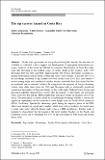| dc.contributor.author | Arozarena, Isabel | |
| dc.contributor.author | Houser, Chris | |
| dc.contributor.author | Gutiérrez-Echeverría, Alejandro | |
| dc.contributor.author | Brannstrom, Christian | |
| dc.date.accessioned | 2020-08-04T21:21:40Z | |
| dc.date.available | 2020-08-04T21:21:40Z | |
| dc.date.issued | 2015-01-31 | |
| dc.identifier.uri | http://hdl.handle.net/11056/17806 | |
| dc.description.abstract | Deaths from rip currents are a major hazard on global beaches, but few data are available at a national scale to support the development of appropriate intervention programs. Analysis of data from the Judicial Investigation Organization of Costa Rica indicates that drowning is the leading cause of violent death in the country, with 1,391 drownings between 2001 and 2012. Approximately 590 of those drownings occurred in a marine environment and are listed as being the result of rip currents. A majority (64 %) of the drownings attributed to rip currents involved victims from Costa Rica and tended to involve young single male students at beaches within a relatively short drive from San Jose on weekends and on national holidays. In comparison, the majority of foreign drowning victims were older males from the USA and Nicaragua with no statistically significant variation in the number of those drownings by day of the week. Predicted wave forcing and measured sediment characteristics suggest that the majority of drownings are associated with a transverse bar and rip (TBR) morphology with quasi-steady rip channels close to the beach. The interannual variation in both local and foreign drownings exhibits a statistically significant dependency on the variation in wave height with the Pacific-North American (PNA) Oscillation. Specifically, drownings peak during the negative phase of the PNA when wave heights are significantly smaller, which may reflect a tendency for beach users to enter calm water when the beach tends to have a TBR morphology. Further study is required to characterize the rip hazard at the most popular beaches on the Pacific and Caribbean coasts and to determine the level of rip knowledge by both local and foreign beach users. | es_ES |
| dc.description.abstract | Las muertes por corrientes de resaca son un peligro importante en las playas mundiales, pero hay pocos datos disponibles a escala nacional para apoyar el desarrollo de programas de intervención apropiados. El análisis de los datos de la Organización de Investigación Judicial de Costa Rica indica que el ahogamiento es la principal causa de muerte violenta en el país, con 1.391 ahogamientos entre 2001 y 2012. Aproximadamente 590 de esos ahogamientos ocurrieron en un entorno marino y se enumeran como resultado de las corrientes de resaca. La mayoría (64%) de los ahogamientos atribuidos a las corrientes de resaca involucraron a víctimas de Costa Rica y tendieron a involucrar a jóvenes estudiantes varones solteros en playas dentro de un viaje relativamente corto desde San José los fines de semana y feriados nacionales. En comparación, la mayoría de las víctimas extranjeras de ahogamiento eran hombres mayores de EE. UU. Y Nicaragua, sin variaciones estadísticamente significativas en el número de ahogamientos por día de la semana. El forzamiento de las olas pronosticado y las características medidas de los sedimentos sugieren que la mayoría de los ahogamientos están asociados con una morfología transversal de barra y rasgadura (TBR) con canales de rasgadura casi estables cerca de la playa. La variación interanual en los ahogamientos tanto locales como extranjeros exhibe una dependencia estadísticamente significativa de la variación en la altura de las olas con la Oscilación Pacífico-Norteamericana (PNA). Específicamente, los ahogamientos alcanzan su punto máximo durante la fase negativa de la ANP cuando las alturas de las olas son significativamente más pequeñas, lo que puede reflejar una tendencia de los usuarios de la playa a entrar en aguas tranquilas cuando la playa tiende a tener una morfología TBR. Se requieren más estudios para caracterizar el peligro de rasgadura en las playas más populares en las costas del Pacífico y el Caribe y para determinar el nivel de conocimiento de rasgadura por parte de los usuarios de playas locales y extranjeras. | es_ES |
| dc.description.sponsorship | Universidad Nacional, Costa Rica | es_ES |
| dc.language.iso | eng | es_ES |
| dc.rights | Acceso abierto | es_ES |
| dc.source | Natural Hazards vol.77 753-768 2015 | es_ES |
| dc.subject | CORRIENTES MARINAS | es_ES |
| dc.subject | RIP CURRENT | es_ES |
| dc.subject | DROWNINGS | es_ES |
| dc.subject | OLAS | es_ES |
| dc.subject | PACIFIC NORTH | es_ES |
| dc.subject | OSCILLATION | es_ES |
| dc.subject | COSTA RICA | es_ES |
| dc.title | The rip current hazard in Costa Rica | es_ES |
| dc.type | http://purl.org/coar/resource_type/c_6501 | es_ES |
| dc.description.procedence | Departamento de Física | es_ES |
| dc.identifier.doi | 10.1007/s11069-015-1626-9 | |

